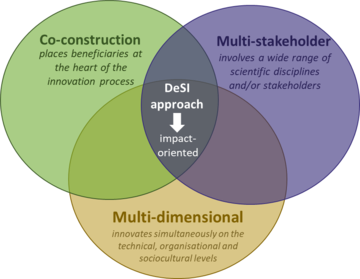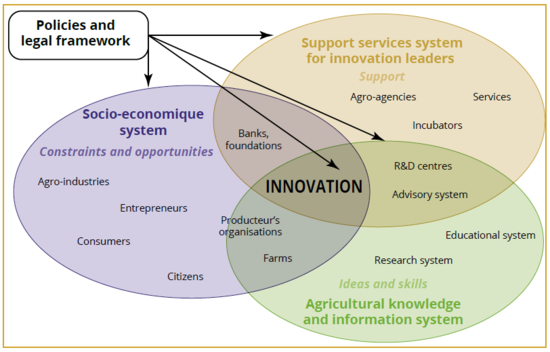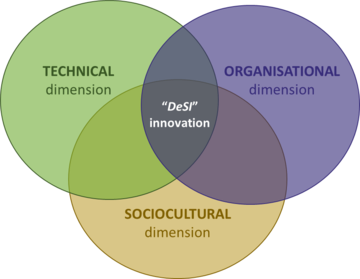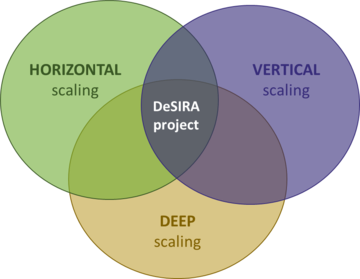Chosen approach
Last update: 15 March 2024
To analyse the approach of the DeSIRA projects
Characterisation of the DeSI approach
In order to conduct a cross-cutting analysis of the research approach specific to the DeSIRA projects, DISSEM-INN has chosen to concentrate on the notion of “Development Smart Innovation (DeSI)”, a shortened version of the title “DeSIRA” given by the European Commission to its initiative (see box above). The challenge was first to define what implementing a DeSI approach actually means for the DeSIRA projects concerned by DISSEM-INN on the basis of their field experience and focusing on “innovation”. A second challenge surrounding this DeSI notion was to gain an understanding of how these DeSIRA projects are consistent, throughout the whole innovation process, with an action research approach that meets development challenges. The uptake of this “DeSI” notion by DISSEM-INN thus provided it with its own specific terminology that is commonly accepted by the DeSIRA projects concerned by its activities, in order to capitalise on their research approach in a cross-cutting manner, beyond their thematic and operational diversity.
This analytical framework underpinned the organisation of the first DISSEM-INN regional workshop on knowledge exchange and cross-cutting capitalisation, which helped to characterise this DeSI innovation approach according to three principles shared by all of these projects:
- co-construction: the beneficiaries targeted are at the heart of the innovation process to facilitate the adaptation and adoption of innovations.
- multi-stakeholder: a wide range of scientific disciplines and partners are involved, all working to support local stakeholders.
- multi-dimensional: the projects do not innovate only on the technical level, but also on the organisational and sociocultural levels (see analytical framework of innovations below).
By following this “DeSI” innovation process, which combines these three principles, the DeSIRA projects pursue an impact-oriented approach aimed at ensuring the sustainability of the changes induced.
Scaling the DeSI approach
To consider the scaling of the DeSI approach at the national level, the DISSEM-INN project takes the perspective of the National Agricultural Innovation System (NAIS). This can be defined as all of the stakeholders involved in agricultural innovation at the national level, divided into three sub-systems depending on whether they participate in agricultural production, knowledge production or support services. An effective NAIS implies the existence of an institutional and policy framework that guides the articulation between these three sub-systems (see diagram below¹).
¹Diagram with colours adapted from FAO, 2023, p. 32.
Thus, in order to promote the scaling of the DeSI approach at the national level, the challenge is to succeed in integrating this approach into the institutional and policy framework governing the NAIS in the country in question.
To do so, the DISSEM-INN project attempts to show how, through the implementation of the DeSI approach, the DeSIRA projects can contribute to strengthening or improving the NAIS in the countries in which they operate. DISSEM-INN thus identifies avenues for advocacy to ensure the DeSI approach, through its integration into the institutional framework governing the NAIS, is more broadly mobilised by the actors involved in agricultural innovation in the country in question.
To analyse the innovations developed by the DeSIRA projects
Analytical framework for “DeSI” innovations
As mentioned above, the third principle of the DeSI approach is its multi-dimensional nature, meaning that the DeSIRA projects develop innovations that combine several dimensions to achieve impact, namely:
- technical (hardware): a “physical” dimension including models, technologies and practices (new variety, equipment, tool, measurement device, computer programme, etc.);
- organisational (orgware): a dimension dealing with ways of working, new institutions or modes of organisation (stakeholder network, innovation platform, value chain, learning methods, etc.);
- sociocultural (software): a dimension covering values, knowledge, ways of thinking or behavioural habits (perception of livestock farming, One Health approach, waste management, etc.).
Analytical framework for their scaling
To analyse the strategies adopted by the DeSIRA projects to scale their DeSI innovations, the DISSEM-INN project mobilises an analytical framework developed by Moore et al.², which distinguishes three methods of dissemination:
- horizontal (scaling out): reaching more people across bigger spaces;
- Level of stakeholders: contextes and populations beyond the initial beneficiaries targeted
- vertical (scaling up): rolling out the innovation by tackling the institutional or systemic roots of the problem;
- Level of institutions: policies, norms and laws
- in depth (scaling deep): sharing and disseminating the norms and values delivered by the innovation by tackling the cultural roots of the problem;
- Level of values: social relations, culture, beliefs and behaviours.
All of the DeSIRA projects implement scaling strategies that cover these three approaches. The challenge for DISSEM-INN is to document the way in which these projects apply these scaling approaches to the innovations they develop, in their different dimensions, and to identify avenues to ensure the knowledge thus generated is used to design strategies at the sub-regional level to support their efforts and to develop new actions.
² MOORE M.-L., RIDDELL D., VOCISANO D., 2015, Scaling out, scaling up, scaling deep: strategies of non-profits in advancing systemic social innovation, Journal of Corporate Citizenship, n° 58, p. 67-84.
Last update: 15 March 2024




